
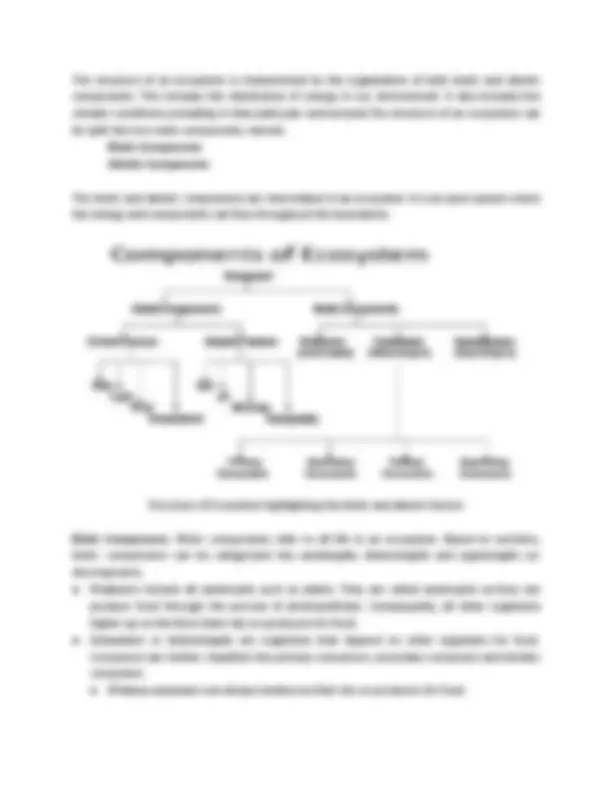
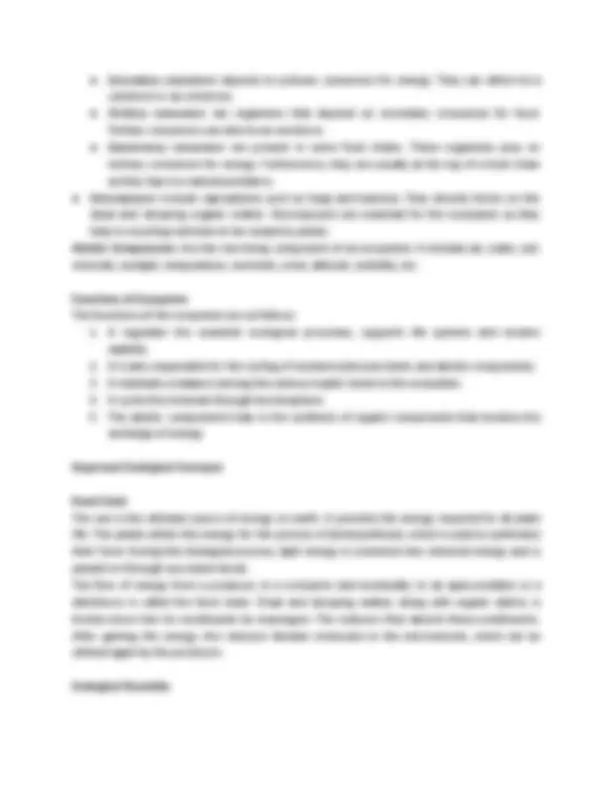
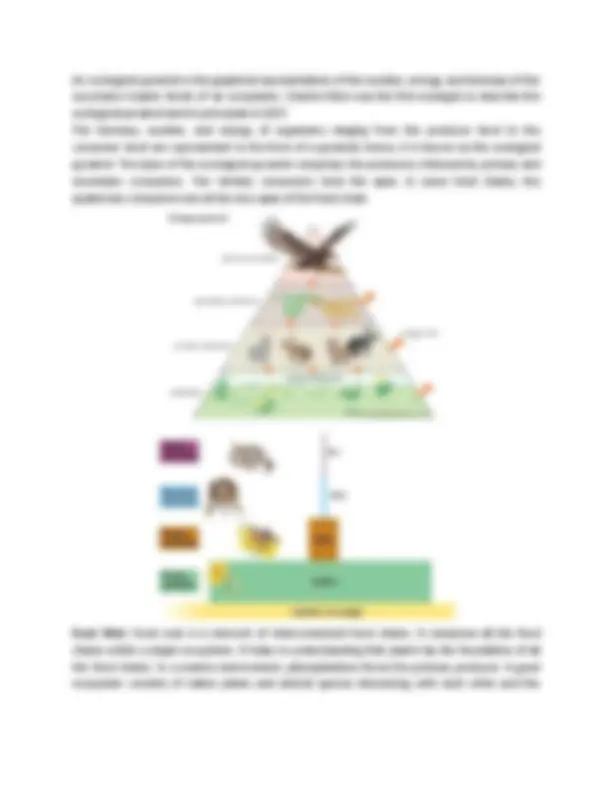
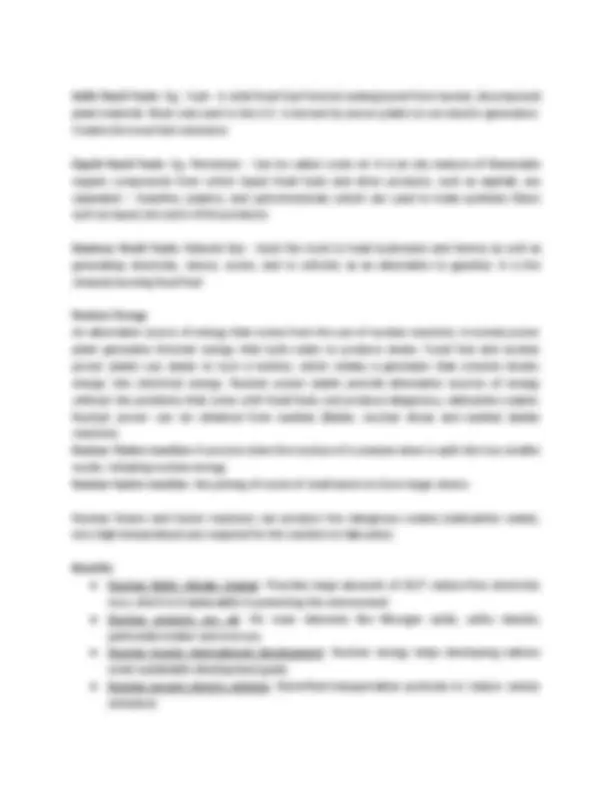
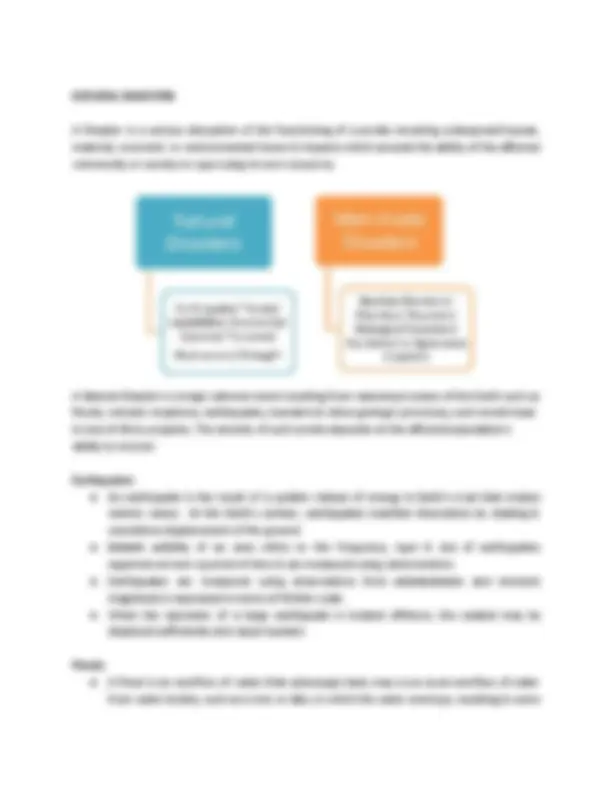
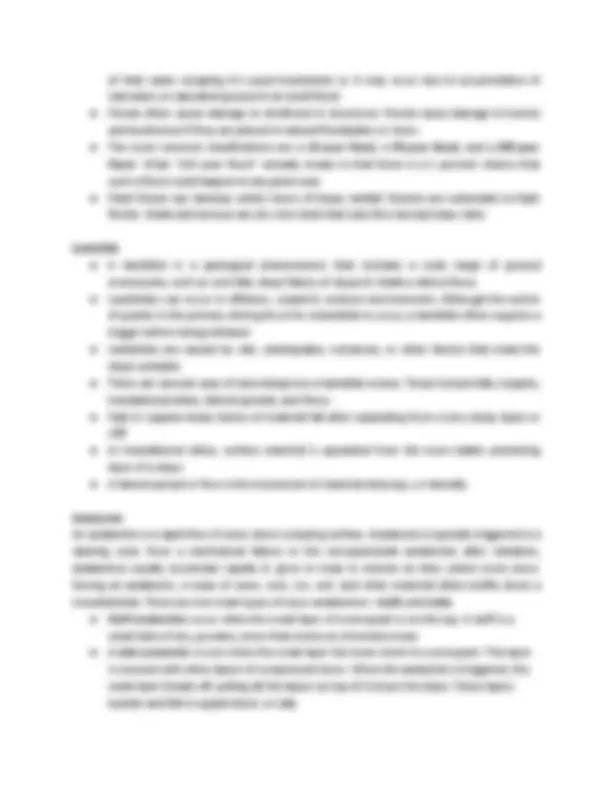
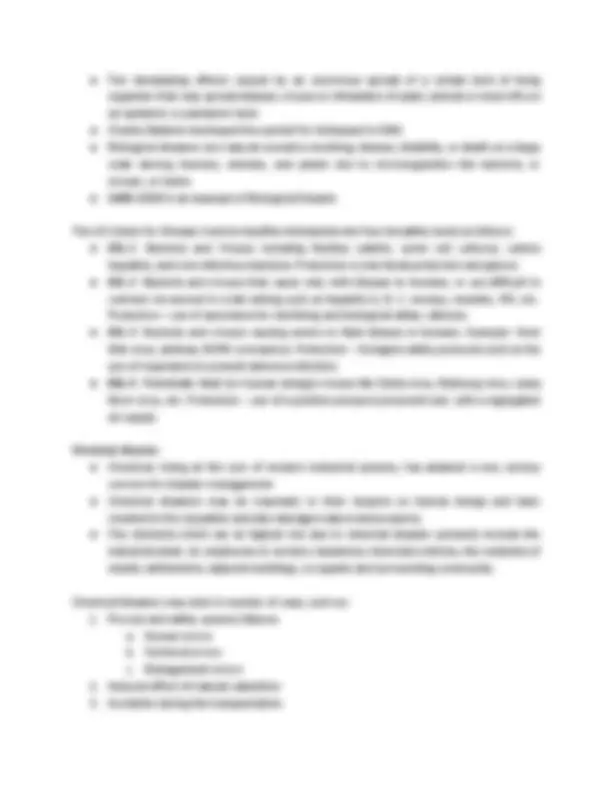
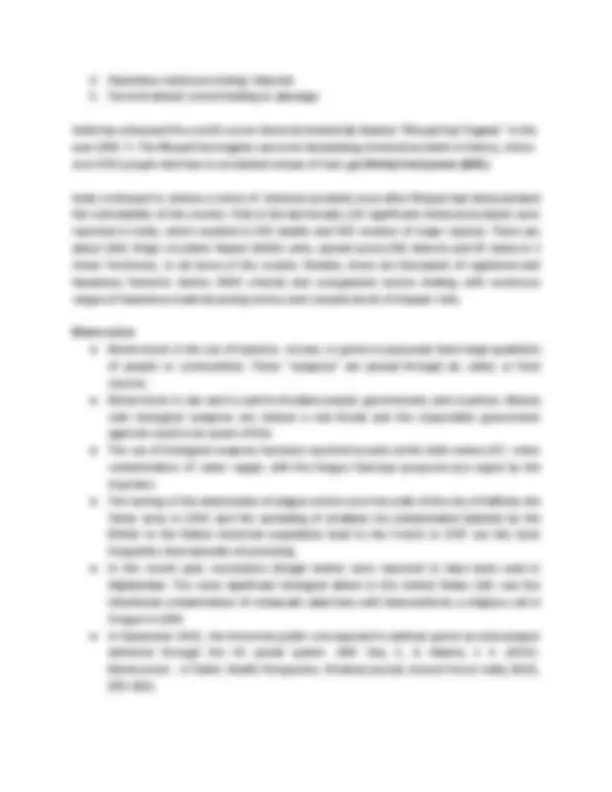


Study with the several resources on Docsity

Earn points by helping other students or get them with a premium plan


Prepare for your exams
Study with the several resources on Docsity

Earn points to download
Earn points by helping other students or get them with a premium plan
Community
Ask the community for help and clear up your study doubts
Discover the best universities in your country according to Docsity users
Free resources
Download our free guides on studying techniques, anxiety management strategies, and thesis advice from Docsity tutors
An overview of ecosystems, focusing on forests and aquatic ecosystems, and discusses the importance of these systems in providing essential services for human society. Additionally, it introduces various energy sources, including renewable options, and their role in powering modern life. Students can use this document as a valuable resource for understanding complex ecological concepts and the interconnectedness of natural systems and energy production.
What you will learn
Typology: Summaries
1 / 14

This page cannot be seen from the preview
Don't miss anything!









Unit 1: Environment and Disaster management Basics of Ecosystem An ecosystem is a geographic area where plants, animals, and other organisms, as well as weather and landscape, work together to form a bubble of life. Ecosystems contain biotic or living, as well as abiotic factors, or nonliving parts. It is a community or group of living organisms that live in and interact with each other in a specific environment. The four ecosystem types are classifications known as artificial, terrestrial, lentic and lotic. Ecosystems are parts of biomes, which are climatic systems of life and organisms. In the biome's ecosystems, there are living and nonliving environmental factors known as biotic and abiotic. Examples of ecosystems are: agroecosystem, aquatic ecosystem, coral reef, desert, forest, human ecosystem, littoral zone, marine ecosystem, prairie, rainforest, savanna, steppe, taiga, tundra, urban ecosystem and others. As a society, we depend on healthy ecosystems to do many things; to purify the air so we can breathe properly, sequester carbon for climate regulation, cycle nutrients so we have access to clean drinking water without costly infrastructure, and pollinate our crops so we don't go hungry. Classification of Ecosystem Based on study area
Types of Ecosystem An ecosystem can be as small as an oasis in a desert, or as big as an ocean, spanning thousands of miles. There are two types of ecosystem: Terrestrial Ecosystem and Aquatic Ecosystem Terrestrial Ecosystems : are exclusively land-based ecosystems. There are different types of terrestrial ecosystems distributed around various geological zones. They are as follows:
● Secondary consumers depend on primary consumers for energy. They can either be a carnivore or an omnivore. ● Tertiary consumers are organisms that depend on secondary consumers for food. Tertiary consumers can also be an omnivore. ● Quaternary consumers are present in some food chains. These organisms prey on tertiary consumers for energy. Furthermore, they are usually at the top of a food chain as they have no natural predators. ● Decomposers include saprophytes such as fungi and bacteria. They directly thrive on the dead and decaying organic matter. Decomposers are essential for the ecosystem as they help in recycling nutrients to be reused by plants. Abiotic Components: Are the non-living component of an ecosystem. It includes air, water, soil, minerals, sunlight, temperature, nutrients, wind, altitude, turbidity, etc. Functions of Ecosystem The functions of the ecosystem are as follows:
An ecological pyramid is the graphical representation of the number, energy, and biomass of the successive trophic levels of an ecosystem. Charles Elton was the first ecologist to describe the ecological pyramid and its principals in 1927. The biomass, number, and energy of organisms ranging from the producer level to the consumer level are represented in the form of a pyramid; hence, it is known as the ecological pyramid. The base of the ecological pyramid comprises the producers, followed by primary and secondary consumers. The tertiary consumers hold the apex. In some food chains, the quaternary consumers are at the very apex of the food chain. Food Web: Food web is a network of interconnected food chains. It comprises all the food chains within a single ecosystem. It helps in understanding that plants lay the foundation of all the food chains. In a marine environment, phytoplankton forms the primary producer. A good ecosystem consists of native plants and animal species interacting with each other and the
● Biomass – Organic matter that contains stored energy or energy produced by heat within the Earth’s crust. Eg.: Plants, wood, and waste – Non-industrialized countries rely heavily on biomass for energy. ● Gasohol- Plant material that is changed into liquid fuel. Eg.: Plants containing sugar or starch can be made into alcohol. The alcohol is burned as a fuel or mixed with gasoline to form the gasohol. ● Geothermal energy – Harness heat from the Earth – Groundwater that seeps into hot spots near the surface of the Earth can form geysers. (Natural vents in which steam and water escape). Eg.: Old Faithful in Yellowstone National Park. The steam is used in power plants to generate electricity. ● Hydroelectric energy – Electricity produced by falling water – Recycled through the water cycle. Eg.: Dams. ● Solar energy – Energy from the sun can be obtained by two common ways (indirectly or directly): ○ Sunlight can be changed into electricity by the use of solar cells. – Ex: solar calculator, solar panels (large panels made up of many solar cells wired together). ○ Solar collectors - dark-colored boxes with glass or plastic tops used to directly heat. ○ Solar mirrors-mirrors that use sunlight to produce electricity for large-scale solar power. ● Wind energy – The energy in wind is exploited for different purposes. Uses wind turbines to convert kinetic energy into electrical energy by rotating a generator Nonrenewable Resources The energy resources that cannot be replaced after they are used or can be replaced only over thousands or millions of years – Fossil fuels and nuclear energy. Coal is obtained either by mining deep beneath the Earth’s surface or by strip mining. Strip mining- a process in which rock and soil are stripped from the Earth’s surface to expose the underlying materials to be mined. Petroleum and natural gas are removed from the Earth by drilling wells into rock that contain these resources. – Oil wells exist on land and in the ocean. The energy resources that formed from the buried remains of plants and animals that lived in swamps millions of years ago – Coal, petroleum, and natural gas. Originally received their energy from the sun. The United States’ primary source of electrical energy is generated by burning fossil fuels.
Solid Fossil Fuels : Eg.: Coal - A solid fossil fuel formed underground from buried, decomposed plant material. Most coal used in the U.S. is burned by power plants to run electric generators. Creates the most fuel emissions Liquid Fossil Fuels : Eg. Petroleum - Can be called crude oil. It is an oily mixture of flammable organic compounds from which liquid fossil fuels and other products, such as asphalt, are separated – Gasoline, plastics, and petrochemicals (which are used to make synthetic fibers such as rayon) are some of the products. Gaseous Fossil Fuels: Natural Gas - Used the most to heat businesses and homes as well as generating electricity, stoves, ovens, and in vehicles as an alternative to gasoline. It is the cleanest burning fossil fuel Nuclear Energy An alternative source of energy that comes from the use of nuclear reactions. A nuclear power plant generates thermal energy that boils water to produce steam. Fossil fuel and nuclear power plants use steam to turn a turbine, which rotates a generator that converts kinetic energy into electrical energy. Nuclear power plants provide alternative sources of energy without the problems that come with fossil fuels, but produce dangerous, radioactive wastes. Nuclear power can be obtained from nuclear fission , nuclear decay and nuclear fusion reactions. Nuclear fission reaction: A process when the nucleus of a uranium atom is split into two smaller nuclei, releasing nuclear energy. Nuclear fusion reaction : the joining of nuclei of small atoms to form larger atoms. Nuclear fission and fusion reactions can produce few dangerous wastes (radioactive waste), very high temperatures are required for the reaction to take place. Benefits ● Nuclear fights climate change- Provides large amounts of 24/7 carbon-free electricity now, which is irreplaceable in protecting the environment ● Nuclear protects our air- No trace elements like Nitrogen oxide, sulfur dioxide, particulate matter and mercury ● Nuclear boosts international development- Nuclear energy helps developing nations meet sustainable development goals. ● Nuclear powers electric vehicles- Electrified transportation promises to reduce carbon emissions
of that water escaping it’s usual boundaries or it may occur due to accumulation of rainwater on saturated ground in an areal flood. ● Floods often cause damage to livelihood & structures. Floods cause damage to homes and businesses if they are placed in natural floodplains or rivers. ● The most common classifications are a 10-year flood , a 50-year flood , and a 100-year flood. What “100-year flood” actually means is that there is a 1 percent chance that such a flood could happen in any given year. ● Flash floods can develop within hours of heavy rainfall. Deserts are vulnerable to flash floods. Wadis and arroyos are dry river beds that only flow during heavy rains. Landslide ● A landslide is a geological phenomenon that includes a wide range of ground movements, such as rock falls, deep failure of slopes & shallow debris flows. ● Landslides can occur in offshore, coastal & onshore environments. Although the action of gravity is the primary driving force for a landslide to occur, a landslide often requires a trigger before being initiated. ● Landslides are caused by rain, earthquakes, volcanoes, or other factors that make the slope unstable. ● There are several ways of describing how a landslide moves. These include falls, topples, translational slides, lateral spreads, and flows. ● Falls & topples-heavy blocks of material fall after separating from a very steep slope or cliff. ● In translational slides, surface material is separated from the more stable underlying layer of a slope. ● A lateral spread or flow is the movement of material sideways, or laterally. Avalanche An avalanche is a rapid flow of snow down a sloping surface. Avalanche is typically triggered in a starting zone from a mechanical failure in the snowpack(slab avalanche) after initiation, avalanches usually accelerate rapidly & grow in mass & volume as they collect more snow. During an avalanche, a mass of snow, rock, ice, soil, and other material slides swiftly down a mountainside. There are two main types of snow avalanches— sluffs and slabs. ● Sluff avalanches occur when the weak layer of a snowpack is on the top. A sluff is a small slide of dry, powdery snow that moves as a formless mass ● A slab avalanche occurs when the weak layer lies lower down in a snowpack. This layer is covered with other layers of compressed snow. When the avalanche is triggered, the weak layer breaks off, pulling all the layers on top of it down the slope. These layers tumble and fall in a giant block, or slab.
Cyclone ● A cyclone is an area of closed, circular fluid motion rotating in the same direction as the Earth. This is usually characterized by inward circular winds that rotate anti-clockwise in the Northern Hemisphere & clockwise in the Southern Hemisphere of the Earth. ● An anticyclone is the opposite of a cyclone. An anticyclone’s winds rotate clockwise in the Northern Hemisphere around a center of high pressure. Air comes in from above and sinks to the ground. High pressure centers generally have fair weather. Tsunami ● In Japanese, tsunami means " harbor wave ". A Tsunami also known as a seismic sea wave, is a series of water waves caused by displacement of a large volume of a body of water, generally an ocean or a large lake. ● Tsunami waves do not resemble normal sea waves as their wavelength is longer. Rather than appearing as a breaking wave. A tsunami may initially resemble a rapidly rising tide & for this reason tsunamis are often referred to as tidal waves. ● Tsunamis race across the sea at up to 500 miles (805 kilometers) an hour—about as fast as a jet airplane. At that pace, they can cross the entire expanse of the Pacific Ocean in less than a day. Drought ● Drought is an extended period when a region receives a deficiency in its water supply, whether atmospheric, surface or groundwater. ● A drought can last for months or years, or may be declared after as few as 15 days, this occurs when a region receives consistently below average precipitation. ● A Drought can have a substantial impact on the ecosystem & agriculture of the affected region. Heat Wave ● A heat wave is a prolonged period of excessively hot weather accompanied by high humidity, especially in oceanic climate countries. It occurs during the summer season in the North-Western parts of India. ● The extreme temperatures and resultant atmospheric conditions adversely affect people living in these regions as they cause physiological stress, sometimes resulting in death. ● The health impacts of Heat Waves typically involve dehydration, heat cramps, heat exhaustion and/or heat stroke. The signs and symptoms are as follows: ○ Heat Cramps : Ederna (swelling) and Syncope (Fainting) generally accompanied by fever below 39C i.e.102F.
● The devastating effects caused by an enormous spread of a certain kind of living organism that may spread disease, viruses or infestation of plant, animal or insect life on an epidemic or pandemic level. ● Charles Baldwin developed the symbol for biohazard in 1966. ● Biological disasters are natural scenarios involving disease, disability, or death on a large scale among humans, animals, and plants due to microorganisms like bacteria, or viruses, or toxins. ● SARS-COV2 is an example of Biological Disaster. The US Center for Disease Control classifies biohazards into four biosafety levels as follows: ● BSL-1 : Bacteria and Viruses including Bacillus subtilis, some cell cultures, canine hepatitis, and non-infectious bacteria. Protection is only facial protection and gloves. ● BSL-2 : Bacteria and viruses that cause only mild disease to humans, or are difficult to contract via aerosol in a lab setting such as hepatitis A, B, C, mumps, measles, HIV, etc. Protection – use of autoclaves for sterilizing and biological safety cabinets. ● BSL-3 : Bacteria and viruses causing severe to fatal disease in humans. Example: West Nile virus, anthrax, MERS coronavirus. Protection – Stringent safety protocols such as the use of respirators to prevent airborne infection. ● BSL-4 : Potentially fatal (to human beings) viruses like Ebola virus, Marburg virus, Lassa fever virus, etc. Protection – use of a positive pressure personnel suit, with a segregated air supply. Chemical disaster ● Chemical, being at the core of modern industrial systems, has attained a very serious concern for disaster management. ● Chemical disasters may be traumatic in their impacts on human beings and have resulted in the casualties and also damages nature and property. ● The elements which are at highest risk due to chemical disaster primarily include the industrial plant, its employees & workers, hazardous chemicals vehicles, the residents of nearby settlements, adjacent buildings, occupants and surrounding community. Chemical disasters may arise in number of ways, such as:-